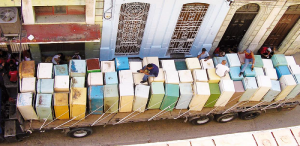
HAVANA, Cuba, January, www.cubanet.org – The reader is not surprised. It’s not about bank loans to buy the cars recently “liberated” by the government. Those are available to anyone who has a good backpack to carry many thousand convertible pesos (CUCs). For now, the fortunate can only acquire on credit electric pressure cookers, conventional rice cookers, electric cookers (one burner) and household goods: a saucepan with a lid, a skillet, a pot and a kettle. How poor are people who require a bank loan to cook!
Some years ago Fidel Castro decided the means of cooking had to be “unified.” The harmful kerosene and liquified gas, always in short supply, were eliminated, which would mean huge savings for the country. Simultaneously, with the campaign to optimize energy resources, the elimination of US-made electric stoves and refrigerators was imposed, although these had performed efficiently for decades.
Trucks were loaded with Chinese equipment for exchange, like it or not, and the grocery stores specifically allotted to corresponding ‘modules’ to every Cuban so they could acquire these goods. Such was the rush, that cash payments or credit contracts were extended to much later, sometimes when the shoddy Chinese products were already broken or unusable.
There are stories of the owner dying of a heart attack while arguing with the “comrade” who was taking the old, but still working, refrigerator, to reject the Chinese one waiting at the door. There’s been no lack of the picaresque: the “Queen pot” (“Queen” is a Chinese brand) was renamed “the traveler” because she spent her life traveling between the kitchen and the repair shop.
It’s not difficult to imagine that most of these gadgets weren’t working for much of the time, and they had raised the price of electricity, while salaries and pensions stayed the same. However, the indispensable electrical appliances offered in the “hard currency collection” stores [as the State named these facilities for ‘collecting’ the remittances Cubans received from their family members living abroad], were sold at high prices in a currency that a considerable share of the population doesn’t possess.
As for new loans, promulgation of the resolution of the Ministry of Domestic Trade and the instruction of the National Bank of Cuba, appeared in the Official Gazette No. 2, 14 January 2014, supplementary to Decree-Law No 289 of 2011; its procedures shall be implemented in the now customary way:
You go to the bank branch to apply for credit (whose amount and timing “will be those resulting from a risk analysis carried out by the bank”). Once approved, you can put the equipment on hold, for a period of five days, at the store that issued the corresponding certificate for its reserve. The bank then issues a check to make payment to the previously chosen store. And in this way, according to the newspaper Granma, more efficient cooking equipment is promoted and the offers of credit to the population are diversified, meeting the guidelines 250 and 52 of the Economic and Social Policy of the Party and the Revolution.
One doesn’t know whether to laugh or cry.
Miriam Leiva, Cubanet, 16 January 2014
For more on this topic see:
The Electrical Re-Involution / Rebeca Monzo
Cold Air or the Fridge Up in the Air / Regina Coyula
